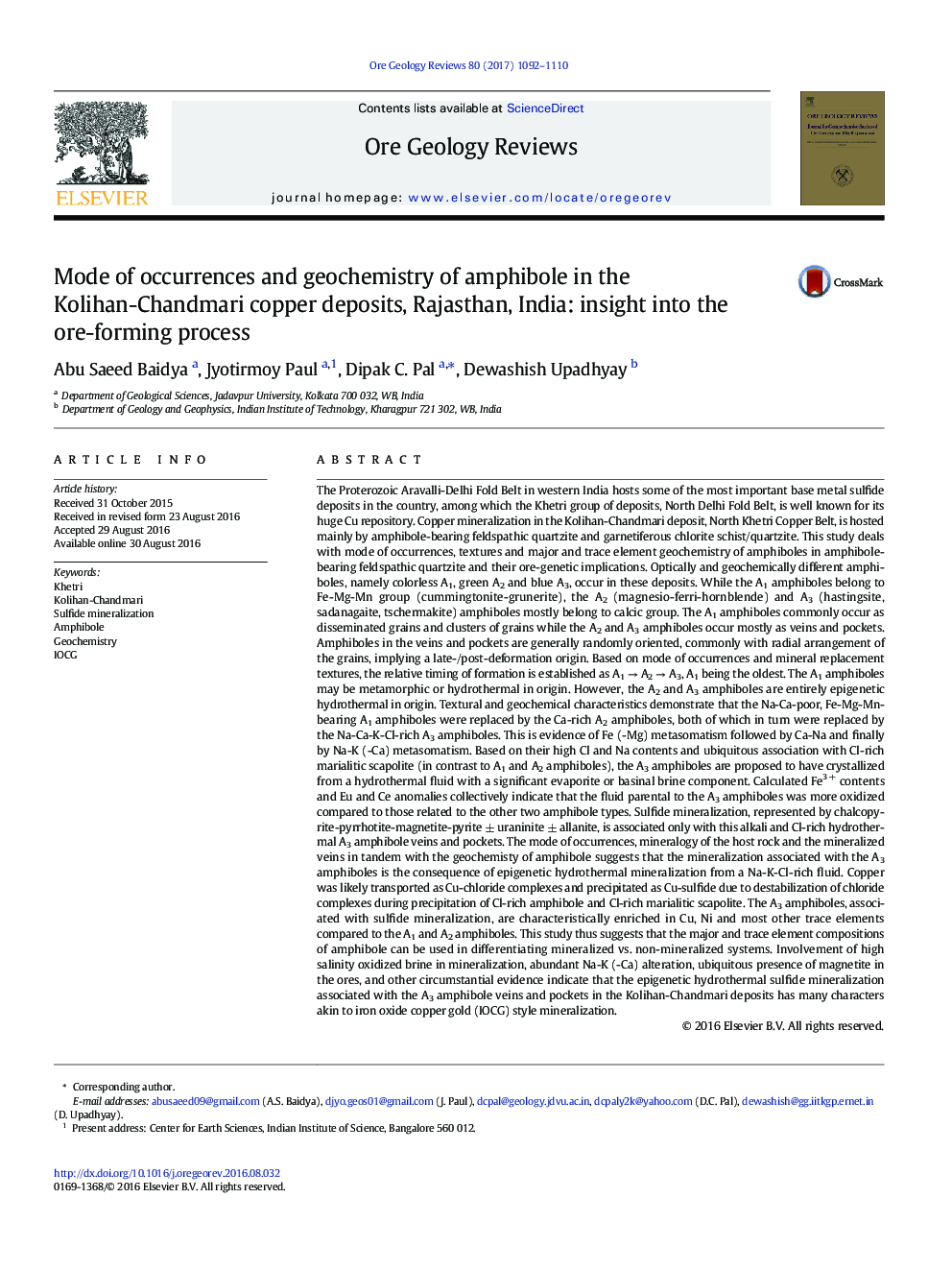| کد مقاله | کد نشریه | سال انتشار | مقاله انگلیسی | نسخه تمام متن |
|---|---|---|---|---|
| 6435688 | 1637226 | 2017 | 19 صفحه PDF | دانلود رایگان |
- Multiple generations of amphibole identified and described.
- Amphiboles geochemically characterized using EPMA and LA-ICP-MS.
- Multiple events of fluid flux vis-Ã -vis epigenetic hydrothermal sulfide mineralization proposed.
- A model of IOCG style mineralization suggested.
The Proterozoic Aravalli-Delhi Fold Belt in western India hosts some of the most important base metal sulfide deposits in the country, among which the Khetri group of deposits, North Delhi Fold Belt, is well known for its huge Cu repository. Copper mineralization in the Kolihan-Chandmari deposit, North Khetri Copper Belt, is hosted mainly by amphibole-bearing feldspathic quartzite and garnetiferous chlorite schist/quartzite. This study deals with mode of occurrences, textures and major and trace element geochemistry of amphiboles in amphibole-bearing feldspathic quartzite and their ore-genetic implications. Optically and geochemically different amphiboles, namely colorless A1, green A2 and blue A3, occur in these deposits. While the A1 amphiboles belong to Fe-Mg-Mn group (cummingtonite-grunerite), the A2 (magnesio-ferri-hornblende) and A3 (hastingsite, sadanagaite, tschermakite) amphiboles mostly belong to calcic group. The A1 amphiboles commonly occur as disseminated grains and clusters of grains while the A2 and A3 amphiboles occur mostly as veins and pockets. Amphiboles in the veins and pockets are generally randomly oriented, commonly with radial arrangement of the grains, implying a late-/post-deformation origin. Based on mode of occurrences and mineral replacement textures, the relative timing of formation is established as A1 â A2 â A3, A1 being the oldest. The A1 amphiboles may be metamorphic or hydrothermal in origin. However, the A2 and A3 amphiboles are entirely epigenetic hydrothermal in origin. Textural and geochemical characteristics demonstrate that the Na-Ca-poor, Fe-Mg-Mn-bearing A1 amphiboles were replaced by the Ca-rich A2 amphiboles, both of which in turn were replaced by the Na-Ca-K-Cl-rich A3 amphiboles. This is evidence of Fe (-Mg) metasomatism followed by Ca-Na and finally by Na-K (-Ca) metasomatism. Based on their high Cl and Na contents and ubiquitous association with Cl-rich marialitic scapolite (in contrast to A1 and A2 amphiboles), the A3 amphiboles are proposed to have crystallized from a hydrothermal fluid with a significant evaporite or basinal brine component. Calculated Fe3 + contents and Eu and Ce anomalies collectively indicate that the fluid parental to the A3 amphiboles was more oxidized compared to those related to the other two amphibole types. Sulfide mineralization, represented by chalcopyrite-pyrrhotite-magnetite-pyrite ± uraninite ± allanite, is associated only with this alkali and Cl-rich hydrothermal A3 amphibole veins and pockets. The mode of occurrences, mineralogy of the host rock and the mineralized veins in tandem with the geochemisty of amphibole suggests that the mineralization associated with the A3 amphiboles is the consequence of epigenetic hydrothermal mineralization from a Na-K-Cl-rich fluid. Copper was likely transported as Cu-chloride complexes and precipitated as Cu-sulfide due to destabilization of chloride complexes during precipitation of Cl-rich amphibole and Cl-rich marialitic scapolite. The A3 amphiboles, associated with sulfide mineralization, are characteristically enriched in Cu, Ni and most other trace elements compared to the A1 and A2 amphiboles. This study thus suggests that the major and trace element compositions of amphibole can be used in differentiating mineralized vs. non-mineralized systems. Involvement of high salinity oxidized brine in mineralization, abundant Na-K (-Ca) alteration, ubiquitous presence of magnetite in the ores, and other circumstantial evidence indicate that the epigenetic hydrothermal sulfide mineralization associated with the A3 amphibole veins and pockets in the Kolihan-Chandmari deposits has many characters akin to iron oxide copper gold (IOCG) style mineralization.
Journal: Ore Geology Reviews - Volume 80, January 2017, Pages 1092-1110
